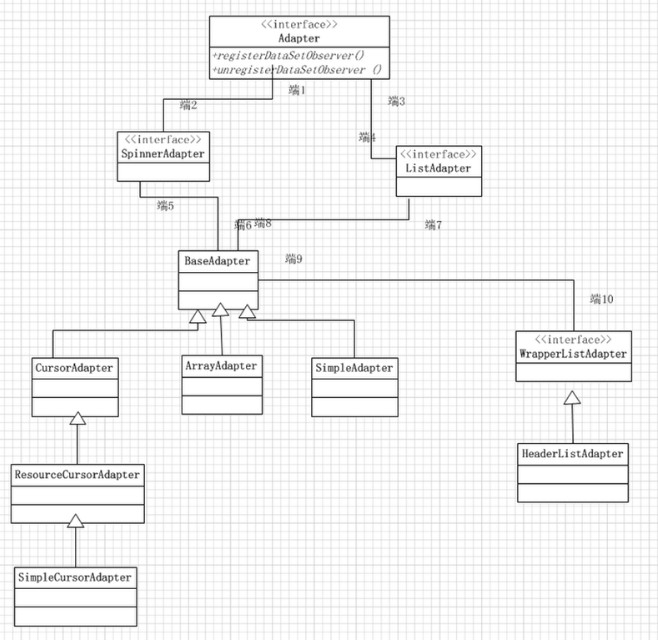Android常用适配器分析
Android中适配器是连接后端数据和前端显示的适配器接口,是数据和UI之间重要的纽带。系统中常见的View有ListView、GridView都要用到Adapter.列表控件是扩展了android.widget.AdapterView的类,包括ListView、GridView、Spinner和Gallery。而AdapterView本身实际上扩展了android.widget.ViewGroup,这意味着ListView、GridView等都是容器控件,换句话说列表控件包含一组视图,适配器的用途是Adapter管理数据,并为其提供子视图。
下图是我在网上找到的比较全的Android适配器结构图:

这里面最常用的几个布局是ArrayAdapter、SimpleAdapter、CursorAdapter以及BaseAdapter。其中BaseAdapter是一个抽象类,需要子类继承并实现其中的接口才能使用,常用于用户自定义显示比较复杂的数据。
1)ArrayAdapter
ArrayAdapter数组适配器是Android中最简单的适配器,专门用于显示列表控件。常用构造方法如下:
public ArrayAdapter(Context context, int textViewResourceId, List objects);
public ArrayAdapter(Context context, int textViewResourceId, T[] objects);
Demo1:
public class MainActivity extends Activity {
private ListView listView;
@Override
protected void onCreate(Bundle savedInstanceState) {
super.onCreate(savedInstanceState);
// setContentView(R.layout.activity_main);
String[] strings = {"1", "2", "3", "4", "5"};
ArrayAdapter<String> adapter = new ArrayAdapter<String>(this, android.R.layout.simple_list_item1, strings);
listView = new ListView(this);
listView.setAdapter(adapter);
setContentView(listView);
}
}
注意:这里资源上针对子布局资源ID的前缀为android,意味着系统不在本地/res目录中查找,会在系统自己的目录中查找。位于SDK文件的platforms/android-version/data/res/layout目录下,我们找到simple_list_item1.xml,其实际内容如下:
<TextView xmlns:android="http://schemas.android.com/apk/res/android"
android:id="@android:id/text1"
android:layout_width="match_parent"
android:layout_height="wrap_content"
android:textAppearance="?android:attr/textAppearanceListItemSmall"
android:gravity="center_vertical"
android:paddingStart="?android:attr/listPreferredItemPaddingStart"
android:paddingEnd="?android:attr/listPreferredItemPaddingEnd"
android:minHeight="?android:attr/listPreferredItemHeightSmall"
/>
这里strings可以是一个字符串数组,也可以是一个List集合。如:
private List<String> getData() {
List<String> data = new ArratList<String>();
data.add("one");
data.add("two");
data.add("three");
data.add("four");
data.add("three");
return data;
}
在代码中我们的Activity可以直接继承于ListActivity,ListActivity类继承与Activity类,默认绑定了一个ListView界面组件,并提供一些与列表视图、处理相关的操作。
Demo2:
public class MainActivity extends ListActivity {
private ListView listView;
@Override
protected void onCreate(Bundle savedInstanceState) {
super.onCreate(savedInstanceState);
ArrayAdapter<String> adapter = new ArrayAdapter<String>(this, android.R.layout.simple_list_item1, getData());
setListAdapter(adapter);
}
private List<String> getData() {
List<String> data = new ArrayList<String>();
data.add("one");
data.add("two");
data.add("three");
return data;
}
}
2)SimpleAdapter
simpleAdapter的扩展性最好,可以定义各种各样的布局,添加ImageView、Button、CheckBox等。
Demo:
simple_list.xml
<?xml version="1.0" encoding="utf-8"?>
<LinearLayout xmlns:android="http://schemas.android.com/apk/res/android"
android:layout_width="fill_parent"
android:layout_height="wrap_content"
android:orientation="horizontal" >
<TextView
android:id="@+id/textView"
android:layout_width="wrap_content"
android:layout_height="wrap_content"
android:layout_margin="20dp"
android:textIsSelectable="true" >
</TextView>
<ImageView
android:id="@+id/img"
android:layout_width="wrap_content"
android:layout_height="wrap_content"
android:layout_margin="20sp" >
</ImageView>
</LinearLayout>
MainActivity.java
public class MainActivity extends ListActivity {
@Override
protected void onCreate(Bundle savedInstanceState) {
// TODO Auto-generated method stub
super.onCreate(savedInstanceState);
String [] strings = new String[] {"title", "img"};
int[] ids = new int[] {R.id.textView, R.id.img};
SimpleAdapter adapter = new SimpleAdapter(this, getData(), R.layout.simple_list, strings, ids);
setListAdapter(adapter);
}
private List<Map<String, Object>> getData() {
List<Map<String, Object>> list = new ArrayList<Map<String,Object>>();
Map<String, Object> map = new HashMap<String, Object>();
map.put("title", "Hello");
map.put("img", R.drawable.iag);
list.add(map);
map = new HashMap<String, Object>();
map.put("title", "world");
map.put("img", R.drawable.ic_launcher);
list.add(map);
return list;
}
}
3)CursorAdapter
一般要以数据库为数据源的时候才会使用SimpleCursorAdapter.这个适配器也需要在ListView中使用,通过游标向列表提供数据。
Demo:
@Override
protected void onCreate(Bundle savedInstanceState) {
// TODO Auto-generated method stub
super.onCreate(savedInstanceState);
Cursor cursor = getContentResolver().query(People.CONTENT_URI, null, null, null, null);
startManagingCursor(cursor);
ListAdapter adapter = new SimpleCursorAdapter(this, R.layout.simple_list, cursor,
new String[] {People.NAME}, new int[] {R.id.textView});
setListAdapter(adapter);
}
4)BaseAdapter
一般用于显示复杂的列表布局,由于BaseAdapter是一个抽象类,使用该类需要自己写一个适配器继承于该类,并重新一些方法。
如下Demo我们通过ApplicationInfoAdapter继承于BaseAdapter,实现一个简单的Launcher,通过PackageManager查询系统中Intent.ACTION_MAIN和Intent.CATEGORY_LAUNCHER的Activity并将其通过ListView的形式显示出来,然后点击某一项进入相应的Activity。
首先我们定义一个描述应用程序的类AppInfo:
public class AppInfo {
private String appLabel; // 应用程序标签
private Drawable appIcon; // 应用程序 的图像
private Intent intent;
private String pkgName; // 应用程序所对应包名
private Context context;
public AppInfo(Context context) {
this.context = context;
}
public String getAppLabel() {
return appLabel;
}
public void setAppLabel(String appName) {
this.appLabel = appName;
}
public Drawable getAppIcon() {
return appIcon;
}
public void setAppIcon(Drawable appIcon) {
this.appIcon = appIcon;
}
public Intent getIntent() {
return intent;
}
public void setIntent(Intent intent) {
this.intent = intent;
}
public String getPkgName() {
return pkgName;
}
public void setPkgName(String pkgName) {
this.pkgName = pkgName;
}
}
然后我们定义一个ApplicationInfoAdapter 继承于BaseAdapter,并重写其getCount(),getItem(),getItemId(),getView()等函数。
public class ApplicationInfoAdapter extends BaseAdapter {
private static final String TAG = "ApplicationInfoAdapter";
private List<AppInfo> mListAppInfo = null;
LayoutInflater infater = null;
public ApplicationInfoAdapter(Context context, List<AppInfo> apps) {
// TODO Auto-generated constructor stub
infater = (LayoutInflater)context.getSystemService(Context.LAYOUT_INFLATER_SERVICE);
mListAppInfo = apps;
}
@Override
public int getCount() {
// TODO Auto-generated method stub
Log.i(TAG, "size="+mListAppInfo.size());
return mListAppInfo.size();
}
@Override
public Object getItem(int arg0) {
// TODO Auto-generated method stub
return mListAppInfo.get(arg0);
}
@Override
public long getItemId(int arg0) {
// TODO Auto-generated method stub
return 0;
}
@Override
public View getView(int position, View convertView, ViewGroup viewGroup) {
// TODO Auto-generated method stub
Log.i(TAG, "getView at" + position);
View view = null;
ViewHolder holder = null;
if(convertView == null || convertView.getTag()==null) {
view = infater.inflate(R.layout.app_list, null);
holder = new ViewHolder(view);
view.setTag(holder);
} else {
view = convertView;
holder = (ViewHolder)convertView.getTag();
}
AppInfo appInfo = (AppInfo)getItem(position);
holder.appIcon.setImageDrawable(appInfo.getAppIcon());
holder.tvAppLabel.setText(appInfo.getAppLabel());
holder.tvPktName.setText(appInfo.getPkgName());
return view;
}
class ViewHolder {
ImageView appIcon;
TextView tvAppLabel;
TextView tvPktName;
public ViewHolder(View view) {
this.appIcon = (ImageView)view.findViewById(R.id.imgApp);
this.tvAppLabel = (TextView)view.findViewById(R.id.tvAppLabel);
this.tvPktName = (TextView)view.findViewById(R.id.tvPkgName);
}
}
}
这里我们通过LAYOUT_INFLATER_SERVICE布局管理器服务动态加载app_list.xml用来显示每一个应用程序的信息
<?xml version="1.0" encoding="utf-8"?>
<LinearLayout xmlns:android="http://schemas.android.com/apk/res/android"
android:layout_width="fill_parent"
android:layout_height="50dp"
android:orientation="horizontal" >
<ImageView android:id="@+id/imgApp"
android:layout_width="wrap_content"
android:layout_height="fill_parent">
</ImageView>
<RelativeLayout
android:layout_width="fill_parent"
android:layout_height="40dp"
android:layout_marginLeft="10dp">
<TextView android:id="@+id/tvLabel"
android:layout_width="wrap_content"
android:layout_height="wrap_content"
android:text="AppLabel:">
</TextView>
<TextView android:id="@+id/tvAppLabel"
android:layout_width="wrap_content"
android:layout_height="wrap_content"
android:layout_marginLeft="3dp"
android:text="Label"
android:layout_toRightOf="@id/tvLabel"
android:textColor="#ffD700">
</TextView>
<TextView android:id="@+id/tvName"
android:layout_width="wrap_content"
android:layout_height="wrap_content"
android:layout_below="@id/tvLabel"
android:text="包名">
</TextView>
<TextView android:id="@+id/tvPkgName"
android:layout_width="wrap_content"
android:layout_height="wrap_content"
android:layout_below="@id/tvAppLabel"
android:layout_alignLeft="@id/tvAppLabel"
android:textColor="#ffD700">
</TextView>
</RelativeLayout>"
</LinearLayout>
然后我们在MainActivity中通过PackageManager查询系统中所有的ACTION_MAIN和 CATEGORY_LAUNCHER的属性的Activity,通过ApplicationInfoAdapter适配器显示到ListView上。
public class MainActivity extends Activity implements OnItemClickListener {
private static final String LOG_TAG = "MainActivity";
private static final int MSG_SUCCESS = 0;
private ListView listView = null;
private List<AppInfo> mListAppInfos = null;
Handler mHandler = null;
@Override
protected void onCreate(Bundle savedInstanceState) {
super.onCreate(savedInstanceState);
setContentView(R.layout.activity_main);
listView = (ListView) this.findViewById(R.id.listView);
mListAppInfos = new ArrayList<AppInfo>();
mHandler = new Handler() {
public void handleMessage(android.os.Message msg) {
switch (msg.what) {
case MSG_SUCCESS:
ApplicationInfoAdapter applicationInfoAdapter = new ApplicationInfoAdapter(
MainActivity.this, mListAppInfos);
listView.setAdapter(applicationInfoAdapter);
listView.setOnItemClickListener(MainActivity.this);
break;
default:
break;
}
};
};
new Thread(new Runnable() {
@Override
public void run() {
// TODO Auto-generated method stub
queryAppInfo(); // 查询所有应用程序信息
mHandler.obtainMessage(MSG_SUCCESS).sendToTarget();
}
}).start();
}
public void queryAppInfo() {
PackageManager pm = this.getPackageManager();
/* List<ApplicationInfo> listApplications = pm.getInstalledApplications(PackageManager.GET_UNINSTALLED_PACKAGES);
Collections.sort(listApplications, new ApplicationInfo.DisplayNameCoamparator(pm));
for(ApplicationInfo app : listApplications) {
if((app.flags & ApplicationInfo.FLAG_SYSTEM) > 0) { // 系统程序
} else if( (app.flags & ApplicationInfo.FLAG_SYSTEM) <= 0) { // 第三方程序
} else if((app.flags & ApplicationInfo.FLAG_UPDATED_SYSTEM_APP) != 0) { // 系统程序被用户更新了
} else if((app.flags & ApplicationInfo.FLAG_EXTERNAL_STORAGE) != 0) { // 安装在SD卡程序
}
}*/
Intent mainIntent = new Intent(Intent.ACTION_MAIN, null);
mainIntent.addCategory(Intent.CATEGORY_LAUNCHER);
// 查询获得所有ResolveInfo对象
List<ResolveInfo> resolveInfos = pm.queryIntentActivities(mainIntent, PackageManager.MATCH_DEFAULT_ONLY);
for(ResolveInfo reInfo : resolveInfos) {
Log.e(LOG_TAG, "name:"+reInfo.activityInfo.name + "pkg:"+reInfo.activityInfo.packageName);
}
// 根据name排序
Collections.sort(resolveInfos, new ResolveInfo.DisplayNameComparator(pm));
for(ResolveInfo reInfo : resolveInfos) {
Log.e(LOG_TAG, "name:"+reInfo.activityInfo.name + "pkg:"+reInfo.activityInfo.packageName);
}
if(mListAppInfos != null) {
mListAppInfos.clear();
for(ResolveInfo reInfo : resolveInfos) {
String activityName = reInfo.activityInfo.name; // 获得应用程序启动Activity的name
String pkgName = reInfo.activityInfo.packageName; // 获得应用程序的包名
String appLabel = (String)reInfo.loadLabel(pm); // 获得应用程序的Label
Drawable icon = reInfo.loadIcon(pm); // 获得应用程序的图标
// 为应用程序的启动Activity准备Intent
Intent launchIntent = new Intent();
launchIntent.setComponent(new ComponentName(pkgName, activityName));
// 创建一个 AppInfo 对象
AppInfo appInfo = new AppInfo(this);
appInfo.setAppLabel(appLabel);
appInfo.setAppIcon(icon);
appInfo.setPkgName(pkgName);
appInfo.setIntent(launchIntent);
mListAppInfos.add(appInfo);
Log.i(LOG_TAG, "ActivityName:"+activityName+ "pkgName:"+pkgName);
}
}
}
@Override
public void onItemClick(AdapterView<?> adapter, View view, int arg2, long arg3) {
// TODO Auto-generated method stub
Intent intent = mListAppInfos.get(arg2).getIntent();
Log.d(LOG_TAG, "intent:"+intent.toString());
startActivity(intent);
}
}

